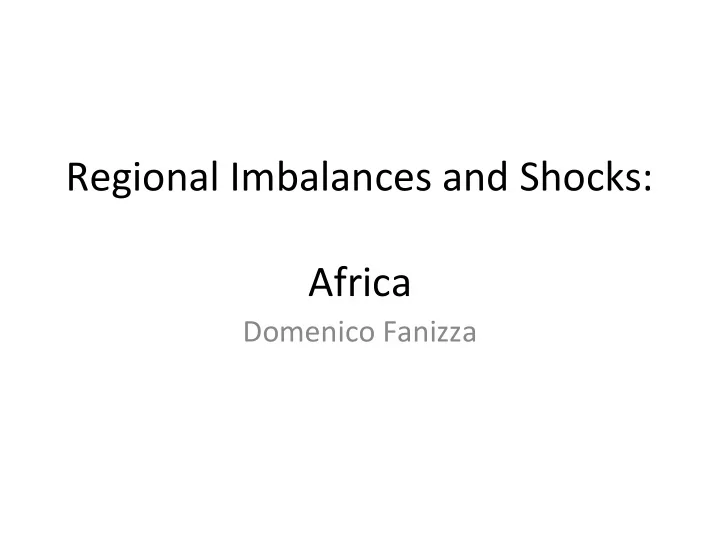

Regional Imbalances and Shocks: Africa Domenico Fanizza
Private vs. Official Financing to Sub-Saharan African Countries 1 • Six-fold increase in volumes • Shift towards private sector 1 Private versus official refers to destination of flows. 2 International Monetary Fund, Regional Economic Outlook for sub-Saharan Africa, April 2011.
Developments in Private Capital Flows during 2010 1 Moderate • Global Strong Recovery Recovery Little Change Decline Factors FDI Ghana, Mauritius Kenya, Zambia Tanzania, Uganda Nigeria – Excess Portfolio Ghana, Mauritius Kenya, Zambia Tanzania, Uganda Nigeria Ghana, Mauritius, liquidity Other Zimbabwe Kenya Tanzania, Uganda Nigeria – Low yields 1 There are insufficient quarterly data for Angola, Mozambique, and Senegal. • Local Factors – Policy rates – Government securities yields – Political uncertainty 3
Comparison of Key Indicators, 2009 SSA Non- SSA Other • Areas of strong Emerging frontier Frontier Frontier Markets Markets Markets Markets performance by Macroeconomic conditions SSA FMs GDP in billions of U.S. dollars (average) 7 40 93 226 – Growth GDP growth projection in percent (average 2011 – 15) 5.3 6.2 5.5 4.9 prospects External debt stocks in percent of GNI (2008) 70.6 21.7 49.2 25.9 – Macroeconomic outcomes Public sector management Strength of legal rights index (0 = weak to – Institutional 10 = strong) 3.9 6.4 5.9 6.1 Total tax rate in percent of profits 79.5 37.0 41.8 44.3 quality Note: Group ranking in individual series, by 3 rd rank color: 1 st rank 2 nd rank 4 th rank 4
A useful analytical grouping of countries in sub-Saharan Africa: oil exporters, middle and low-income countries Sub-Saharan Africa: Selected Indicators, 2011 Number of Share of PPPGDP GDP per Weights Countries Population Capita (U.S. (Percent) (Percent) dollars) Oil Exporters 7 27 34 2,130 Middle-income Countries 8 8 33 7,165 Low-income Countries 1 29 66 33 574 Sources: IMF, World Economic Outlook ; and IMF, African Department database. 1/ Non-oil LICs 5 .
Average Stock of Portfolio Investment Sub-Saharan Africa Frontier Markets: Liabilities 1 Consolidated Foreign Bank Claims 1 Excludes Liberia, Mauritius, Nigeria, and South Africa 6
Four themes set to dominate the policy agenda: 1. Recovery to pre-crisis growth rates is underway in most countries 2. The crisis has nonetheless caused considerable dislocation 3. Tension between the need to rebuild policy buffers and the longer-term spending needs 4. And now countries need to deal with another food and fuel price shock – one that may be more persistent than in 2007-08. 7
8 International Monetary Fund, Regional Economic Outlook for sub-Saharan Africa, April 2011.
Real GDP Growth 9
• Employment outcomes – an extreme case is South Africa • Smaller members of the South Africa Customs Union hit badly too – exports of precious stones declined – revenues from import duties dropped • Fiscal policy – In some countries, fiscal policy had to be tightened (e.g. Ghana and Angola) • Elsewhere, including in the many LICs where growth decelerated only marginally, those at the margins of the labor market were likely also affected greatly. 10 .
11 International Monetary Fund, Regional Economic Outlook for sub-Saharan Africa, April 2011.
• In a number of countries, the harvest has been strong keeping domestic prices contained • The increase in world prices has also been less uniform across major crops than in 2008 • Nonetheless, domestic food prices have increased sharply in a number of countries. Factors at work include poor harvests (e.g. Kenya), net staple food importers being hit by higher international prices (Ethiopia), political crisis (Madagascar). • To cushion the adverse effects, some countries have introduced price controls and subsidies. 12
13
• Fiscal policy – Should continue to move away from supportive stance of the last few years to a more neutral stance as soon as feasible – Focus should be on rebuilding policy buffers • Monetary policy – Given the recent uptick in inflation, there is need for tightening bias in most countries 14
Sub-Saharan Africa: Overall Balance Excluding Grants, 2000–12 Where food price increases have been pronounced, interventions targeted at the neediest groups should be adopted What of fuel price subsidies? In general, these should be avoided because they are regressive and very costly 15 .
• Recovery is under way in most of the region’s oil Sub-Saharan Africa: exporters and low-income countries; southern Africa is 2011 Growth Outlook where recovery to pre-crisis growth rates is likely to be beyond reach for some time • Growth in many low income countries barely slowed in the global recession and is again comfortably above 5 percent. • Eastern Africa countries are faring particularly well: Mozambique, Tanzania, Uganda and Malawi and Zambia. Real GDP Growth Also some oil exporters: Nigeria, Republic of Congo. (in percent) > 7 • Resilience evident throughout SSA, mainly because of 3.5 – 7 much improved policies prior to global recession. 2 – 3.5 0 to 2 <0 • Risks now come from rising government debt levels in some countries and the current food and fuel price shock, which will impact on poverty, fiscal and external balances and inflation. 16 .
Recommend
More recommend